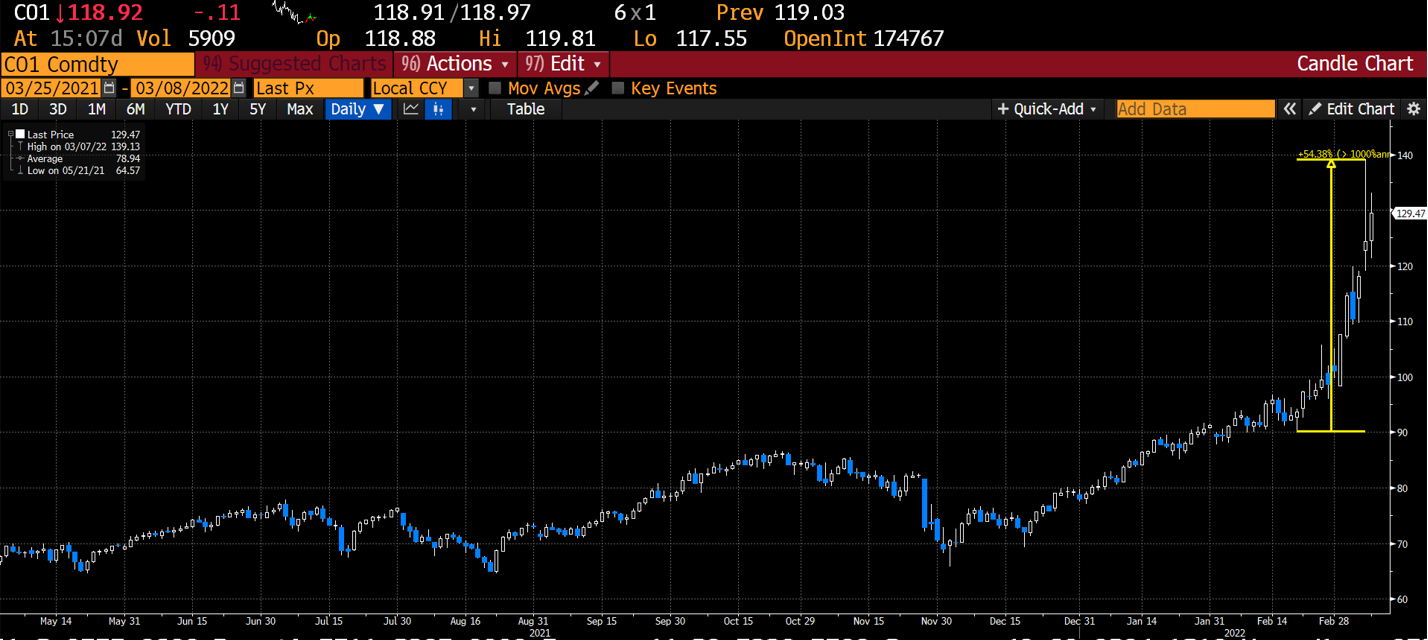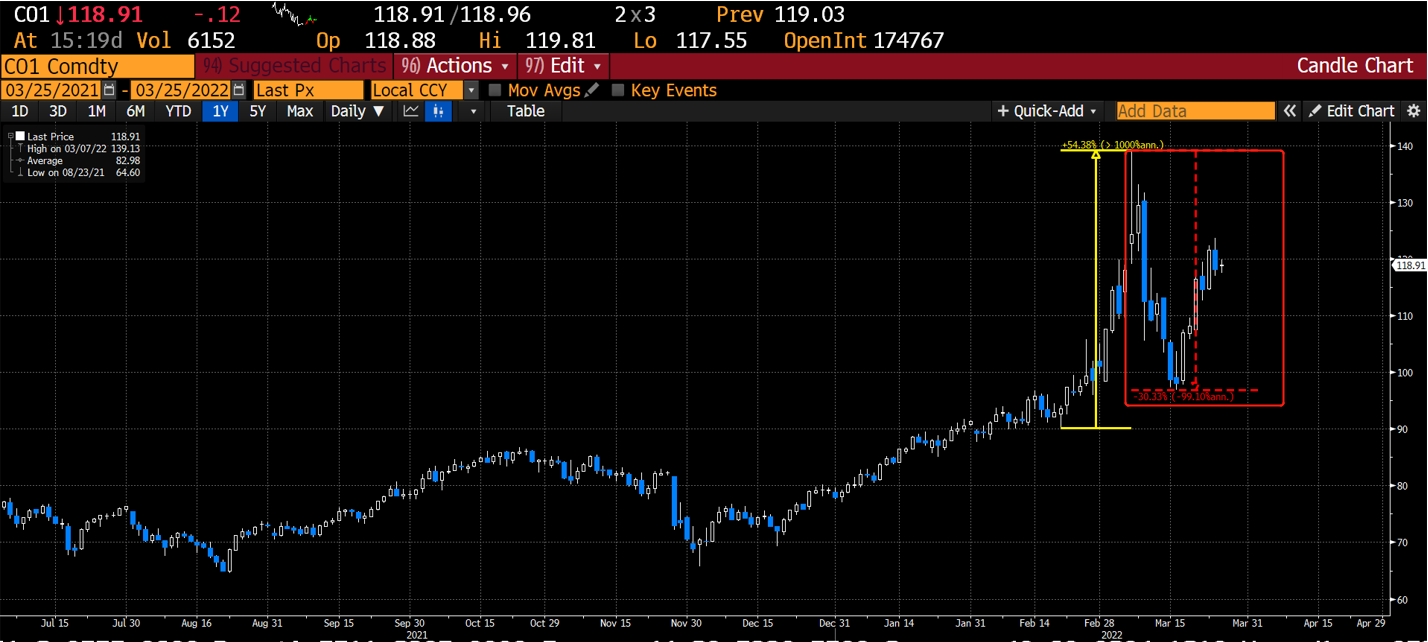Oil Used as a Weapon of War? May 4, 2022

The Russia-Ukraine war has significantly impacted the global economy in various ways. One major impact has been the close monitoring of crude oil prices by traders, be it West Texas Intermediate (WTI) or Brent Crude, as Russia is one of the world’s largest producers of oil.
Russia has been significantly impacted by the imposed sanctions, and it is evident that there will be an oil supply shortage, which will ultimately drive prices higher.
Now let’s look at:
- The escalation of geopolitical conflicts
- Oil reshaping the global map of energy trade/geopolitics
- Oil-related stock trading opportunities
Start trading on POEMS! Open a free account here!
Organization of Petroleum Exporting Countries (OPEC)
OPEC was established in 1960 with Iran, Iraq, Kuwait, Saudi Arabia and Venezuela as its founding members. The organization later expanded to include 15 major oil exporting nations [2]; and its aim was to regulate the supply of oil in order to set a benchmark for oil prices.
However, with the arrival of fracking technology within the oil industry, there was a reduction in OPEC’s ability to control the world oil market [3].
While OPEC does ensure that there is a steady supply of oil to the global markets, it has come under fire for its considerable power in the industry, which allows it to control prices and potentially keep them as high as possible.

The ongoing Russia-Ukraine conflict, which emerged from geopolitical tensions, has resulted in a liquidity crunch. This has contributed to the volatility within the oil markets and has made prices vulnerable to big swings, causing a whipsawed market. As a result of this, traders are now proceeding with extreme caution with regards to Russian crude oil [4].
Meanwhile, as a result of inflationary pressures, the US Federal Reserve has raised interest rate hikes and signalled potential further increases.
With inflation spiralling, this has led to a dilemma for policy makers (central banks and governments) as they attempt to revive economic growth in the aftermath of the COVID-19 pandemic.
A recent comment from Libya, stating that OPEC should continue to bolster its production in a bid to ease the current energy supply crisis has also impacted oil prices, pushing them lower. Saudi Arabia’s Crown Prince Mohammed bin Salman told the Japanese Prime Minister that the kingdom was keen to maintain the oil market’s balance and stability, state-run SPA reported. [5]

Oil prices began to fall as Libya urged OPEC to increase its supply, with further support from the potential peace negotiations between both Russia and Ukraine. This resulted in the futures closing 1.5% lower after trading at more than $5 per barrel higher from 10 March 2022 [6]. Russia also said that if Ukraine were to remain a neutral country and retain its own armed forces, a compromise in the conflict could be achieved.
Separately, the International Energy Agency said that the production of oil from Russia could be reduced by a quarter and that the current inflated price would lead to a reduced demand in oil.
On the COVID-19 front, China is battling a new wave of infections, and lockdowns have been imposed on cities like Shanghai. Even though Shanghai is one of China’s biggest cities and a global financial hub, it now has less traffic as compared to before and we can therefore infer that a potential downside in demand could occur judging from the transportation sector itself [7].
As for the US, it is seen to have increased its stockpile of crude at the nation’s biggest storage hub, to assist in mitigating supply concerns. Rising oil prices also pose a significant political risk for the US administration [8].
In another development, major oil importers are placing pressure on OPEC to increase output.
Brent surged to approximately $140 a barrel in March 2022. But the price then retreated to under $100, which was a drop of more than 20% indicating a bearish market.
The extent of liquidation shows up in open interest figures while oil futures were also observed to have fallen to their lowest since 2015, with Brent and WTI combined [9].
ETF recommendation
Despite all these developments, investors may still be looking to invest in the oil sector.
One option to get direct access to the oil market is through ETFs that track the commodity, such as the 2 ETFs listed below, which you can consider including into your portfolio.
United States Oil Fund LP (USO)
- NAV: $76.06
- Expense Ratio: 0.83%
- Management Fee: 0.45%
- Performance Over One-Year: 63.83%
- Total Net Assets: $3.27 billion
- Inception Date: April 10, 2006
- Issuer: USCF Investments
(Source: USCF Investments [13], as of 04 April 2022)
USO is structured as a commodity pool, and it is denoted as a private investment structure that compiles investor funds to trade in both the futures and commodities markets. It is traded on the New York Mercantile Exchange (NYMEX).
USO also invests in various oil-related contracts.
United States Brent Oil Fund (BNO)
- NAV: $30.38
- Expense Ratio: 1.13%
- Management Fee: 0.75%
- Performance Over One-Year: 61.66%
- Total Net Assets: $281.035 million
- Inception Date: June 2, 2010
- Issuer: USCF Investments
(Source: USCF Investments [14], as of 05 April 2022)
BNO is structured as a commodity pool, and the daily percentage changes in its shares’ net asset value (NAV) reflect the daily percentage changes in the spot price of Brent Crude oil, as measured by changes in price of BNO’s Benchmark Oil Futures Contract. The benchmark is a near-month futures contract that is traded on the ICE Futures Exchange. Brent Crude are often traded at a different price point from WTI, and as such BNO can be an alternative method to gain exposure to the oil market. BNO primarily consists of Brent crude oil futures contracts and other oil-related futures contracts.
Conclusion
The relentless surge of oil prices threatens to stoke inflation cross the globe and is forcing central banks to decide whether to respond to higher prices with tighter policies. However, it seems that the market is poised for a period of high-energy prices that are driven by war and combined with tight market fundamentals. Clearly the war and sanctions continue to increase pressure on the system, and the risk of disruption to supplies might not be fully priced in at this moment.
Want to get daily updates on market events? You can join our Telegram Channel here.

Explore a myriad of useful features including TradingView chartings to conduct technical analysis with over 100 technical indicators available!
Take this opportunity to expand your trading portfolio with our wide range of products including Stocks, CFDs, ETFs, Unit Trusts and more across 15 global exchanges available for you anytime and anywhere to elevate you as a better trader using our POEMS Mobile 3 App!
Reference:
- [1] https://www.fia.org/marketvoice/articles/battle-benchmarks-brent-vs-wti-crude-oil-futures
- [2] https://www.opec.org/opec_web/en/about_us/24.htm
- [3] https://www.sciencedirect.com/topics/economics-econometrics-and-finance/opec-countries
- [4] https://www.weforum.org/agenda/2022/03/how-does-the-war-in-ukraine-affect-oil-prices/
- [5] https://www.reuters.com/world/middle-east/saudi-crown-prince-stresses-importance-maintaining-opec-agreement-saudi-state-2022-03-17/
- [6] https://www.reuters.com/business/energy/oil-rebounds-escalating-ukraine-conflict-raises-supply-concerns-2022-03-04/
- [7] https://www.nytimes.com/2022/03/15/business/oil-prices-china.html
- [8] https://edition.cnn.com/2022/03/01/politics/us-strategic-petroleum-reserve-release-latest/index.html
- [9] https://markets.businessinsider.com/news/commodities/oil-surges-130-dollars-a-barrel-russia-crude-ban-fears-2022-3
- [10] https://www.investopedia.com/news/5-etfs-track-oil-usodbooilucouwti/
- [11] https://www.poems.com.sg/etf-screener/NYSE-USO/
- [12] https://www.poems.com.sg/etf-screener/NYSE-BNO/
- [13] https://www.uscfinvestments.com/uso
- [14] https://www.uscfinvestments.com/bno
Disclaimer
These commentaries are intended for general circulation. It does not have regard to the specific investment objectives, financial situation and particular needs of any person who may receive this document. Accordingly, no warranty whatsoever is given and no liability whatsoever is accepted for any loss arising whether directly or indirectly as a result of any person acting based on this information. Opinions expressed in these commentaries are subject to change without notice. Investments are subject to investment risks including the possible loss of the principal amount invested. The value of the units and the income from them may fall as well as rise. Past performance figures as well as any projection or forecast used in these commentaries are not necessarily indicative of future or likely performance. Phillip Securities Pte Ltd (PSPL), its directors, connected persons or employees may from time to time have an interest in the financial instruments mentioned in these commentaries. Investors may wish to seek advice from a financial adviser before investing. In the event that investors choose not to seek advice from a financial adviser, they should consider whether the investment is suitable for them.
The information contained in these commentaries has been obtained from public sources which PSPL has no reason to believe are unreliable and any analysis, forecasts, projections, expectations and opinions (collectively the “Research”) contained in these commentaries are based on such information and are expressions of belief only. PSPL has not verified this information and no representation or warranty, express or implied, is made that such information or Research is accurate, complete or verified or should be relied upon as such. Any such information or Research contained in these commentaries are subject to change, and PSPL shall not have any responsibility to maintain the information or Research made available or to supply any corrections, updates or releases in connection therewith. In no event will PSPL be liable for any special, indirect, incidental or consequential damages which may be incurred from the use of the information or Research made available, even if it has been advised of the possibility of such damages. The companies and their employees mentioned in these commentaries cannot be held liable for any errors, inaccuracies and/or omissions howsoever caused. Any opinion or advice herein is made on a general basis and is subject to change without notice. The information provided in these commentaries may contain optimistic statements regarding future events or future financial performance of countries, markets or companies. You must make your own financial assessment of the relevance, accuracy and adequacy of the information provided in these commentaries.
Views and any strategies described in these commentaries may not be suitable for all investors. Opinions expressed herein may differ from the opinions expressed by other units of PSPL or its connected persons and associates. Any reference to or discussion of investment products or commodities in these commentaries is purely for illustrative purposes only and must not be construed as a recommendation, an offer or solicitation for the subscription, purchase or sale of the investment products or commodities mentioned.
About the author
Louis Tan
Equities Dealer
Louis joined Phillip Securities in Aug 2021 as an Equity Dealer in the Global Markets Team. He specializes in the Day markets assisting clients and supporting the South East Asian markets. Louis graduated from Singapore Institute of Management, Royal Melbourne Institute of Technology (SIM-GE) in 2020 with a bachelor’s degree in Economics & Finance. He migrated over from the banking industry, looking to further improve his investment knowledge.

 Japan’s Economic Resurgence: Unveiling the Tailwinds Behind Nikkei 225’s Record Leap
Japan’s Economic Resurgence: Unveiling the Tailwinds Behind Nikkei 225’s Record Leap  How to soar higher with Positive Carry!
How to soar higher with Positive Carry! ![[Smart Park] Buy Insurance, Get Rich Quick? Not Exactly, But This Comes Close [Smart Park] Buy Insurance, Get Rich Quick? Not Exactly, But This Comes Close](https://www.poems.com.sg/wp-content/uploads/2024/03/Valerie-Lim-LI-X-SMART-Park-Article-300x157.jpg) [Smart Park] Buy Insurance, Get Rich Quick? Not Exactly, But This Comes Close
[Smart Park] Buy Insurance, Get Rich Quick? Not Exactly, But This Comes Close  Deciphering the Updates: Understanding the latest CPF Changes
Deciphering the Updates: Understanding the latest CPF Changes 









